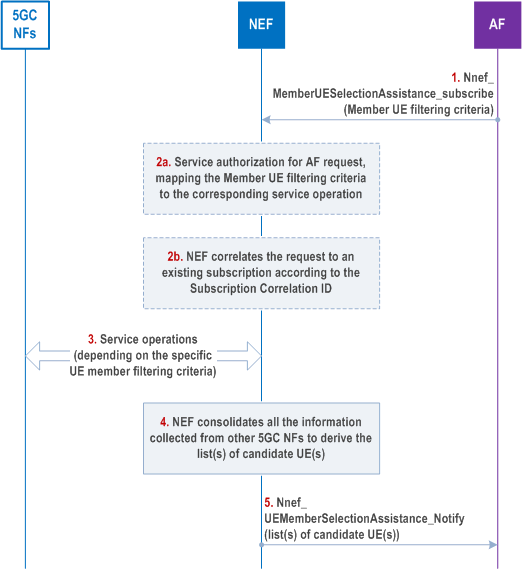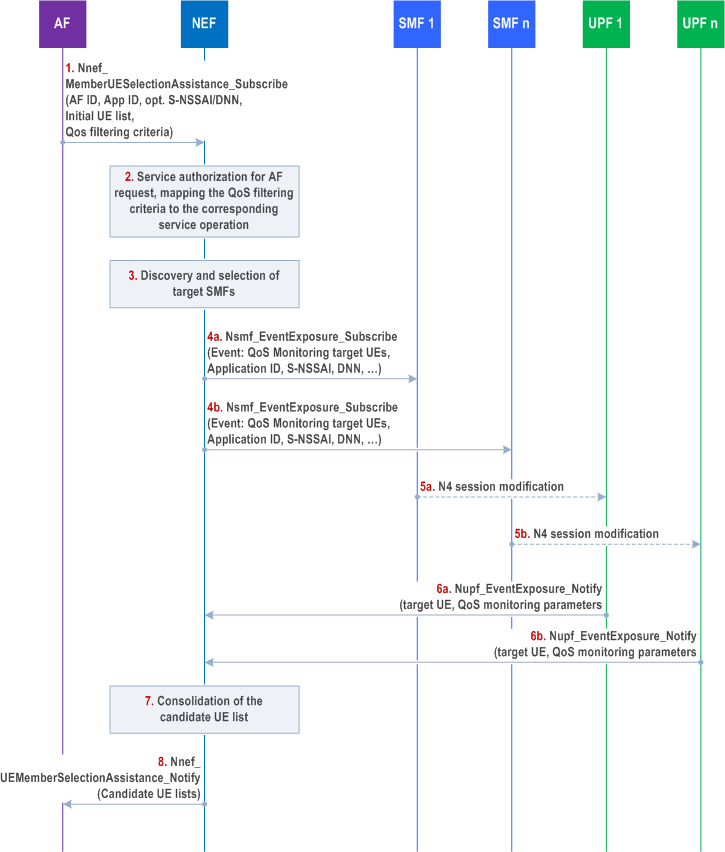Content for TS 23.502 Word version: 19.0.0
1…
4.2.2.2.2
4.2.2.2.3…
4.2.2.3…
4.2.3…
4.2.3.3
4.2.4…
4.2.6
4.2.7…
4.2.9…
4.2.11…
4.2.11.5…
4.3…
4.3.2.2.2
4.3.2.2.3…
4.3.3…
4.3.3.3
4.3.4…
4.3.4.3
4.3.5…
4.3.5.2…
4.3.5.4…
4.3.5.6…
4.3.6…
4.4…
4.5…
4.9…
4.9.1.3…
4.9.2…
4.11…
4.11.1…
4.11.1.2.2
4.11.1.2.3
4.11.1.3…
4.11.1.3.3…
4.11.1.4…
4.11.1.5…
4.11.2…
4.11.3…
4.12…
4.12.6…
4.12a…
4.12b…
4.13…
4.13.4…
4.13.6…
4.14…
4.15…
4.15.3.2.5…
4.15.4…
4.15.6…
4.15.6.7…
4.15.6.13…
4.15.6.14…
4.15.9…
4.15.9.4…
4.15.13…
4.15.13.4…
4.16…
4.16.4…
4.16.8…
4.16.11…
4.16.14…
4.16.15…
4.17…
4.17.9…
4.18…
4.19…
4.22…
4.23…
4.23.7…
4.23.7.3.3
4.23.7.3.4…
4.23.9…
4.23.9.4…
4.23.11…
4.24…
4.25…
4.25.6…
4.26…
5…
5.2.3…
5.2.5…
5.2.6…
5.2.7…
5.2.8…
5.2.9…
5.2.12…
5.2.18…
A…
E…
F…
G
H…
4.15.13 Assistance for Member UE selection
4.15.13.0 General
4.15.13.1 Member UE selection assistance subscribe and update procedure
4.15.13.2 Member UE Filtering Criteria for 5GS assistance to Member UE selection
4.15.13.3 Specific procedure for QoS Member UE filtering criteria
...
...
4.15.13 Assistance for Member UE selection |R18| p. 493
4.15.13.0 General p. 493
Assistance for Member UE selection allows the AF to request the 5GC to filter a list of AF provided target member UEs according to AF provided criteria (Member UE filtering criteria) and to provide one or more list(s) of candidate UEs (and additional information) as response to the AF.
With the initial subscription request, the AF provides a list of target member UEs in the form of a list of GPSIs or a list of UE IP addresses and at least one Member UE filtering criterion as part of the service operation input parameters to assist the candidate UEs selection. Upon receiving the AF request, NEF triggers corresponding 5GC procedures to retrieve from 5GC NFs the information for the UEs in the list of target member UEs. Before sending the list(s) of candidate UEs to the AF, NEF consolidates all the information collected from other 5GC NFs and derives one or more list(s) of candidate UEs and possibly additional information according to the Member UE filtering criteria provided by the AF. The NEF finally provides the one or more list(s) of candidate UEs and possibly additional information to the AF together with a Subscription Correlation ID.
AF may subsequently update the parameters for the Member UE filtering criteria, the Member UE filtering criteria, or the Member UE filtering criteria values. In all cases, AF includes the Subscription Correlation ID in the request, but does not include the list of target member UEs. AF may request to update the parameters (e.g. expiry time, time window for selecting the candidate UEs) for the subscribed Member UE filtering criteria. AF may also request to update the Member UE filtering criteria by adding new Member UE filtering criteria or removing part of the subscribed Member UE filtering criteria. The AF may also request to update the Member UE filtering criteria values.
The Member UE selection assistance capability can be used to assist the AF to select the list of member UEs to support application service (e.g. FL operation) as described in clause 5.46.2 of TS 23.501.
Additionally, AF may leverage the 5GC network exposure for Member UE selection without the NEF assistance as described in clause 5.46.2 of TS 23.501. An example of how the AF leverages the 5GC network exposure for Member UE selection is described in (informative) Annex I.
AF may also delete the previous subscription for Member UE selection assistance as described in clause 4.15.13.7.
4.15.13.1 Member UE selection assistance subscribe and update procedure p. 493
This clause describes the Member UE selection assistance subscribe and update procedure that is generally applicable independently of the Member UE filtering criteria sent by the AF.

Step 1.
AF subscribes the Member UE selection assistance by sending a Nnef_MemberUESelectionAssistance_subscribe request including a list of target member UEs, one or more member UE filtering criteria as listed in Table 4.15.13.2-1 and optionally, time window(s). Subsequently, the AF may only update the Member UE filtering criteria of the subscription as described in clause 4.15.13.0 by invoking Nnef_MemberUESelectionAssistance_subscribe and providing a Subscription Correlation ID, i.e. the AF does not provide the list of target member UEs again.
Step 2a.
[CONDITIONAL] If the AF request does not contain a Subscription Correlation ID, the NEF verifies the authorization of the AF request and identifies which information needs to be collected for each UE in the list of target member UEs and executes the corresponding service operations based on the Member UE filtering criteria provided by the AF, e.g. events, analytics ID(s), notifications, etc.
Step 2b.
[CONDITIONAL] If the AF request contains a Subscription Correlation ID, the NEF correlates the Nnef_MemberUESelectionAssistance_Subscribe request to an existing subscription according to the Subscription Correlation ID. The NEF updates the Member UE filtering criteria and/or their parameters (as described in clause 4.15.13.0) for the list of target member UEs received in initial subscription (i.e. no Subscription Correlation ID in the subscription request).
Step 3.
NEF interacts with different 5GC network functions to collect the required information for each UE in the list of target member UEs. The set of interactions between the NEF and the 5GC NFs depend on the Member UE filtering criteria provided by the AF. See Table 4.15.13.2-1 for details.
Step 4.
Based on the collected information from other 5GC NFs, the NEF consolidates all the information to derive the list(s) of candidate UEs which fulfil the Member UE filtering criteria in the AF request. The NEF may derive recommended time window(s), considering the validity period(s) of the analytics used for Member UE selection criteria. The recommended time window(s) may be a subset of the time window(s) received from the AF. In different recommended time windows, the list of candidate UEs which fulfil the Member UE filtering criteria may be different.
Step 5.
NEF sends a Nnef_MemberUESelectionAssistance_Notify request to the AF including the list(s) of candidate UEs and possibly additional information. See clause 5.2.6.32.4 for details.
4.15.13.2 Member UE Filtering Criteria for 5GS assistance to Member UE selection p. 495
Table 4.15.13.2-1 provides a summary of the Member UE filtering criteria that the AF may request.
| Member UE filtering criteria | Description of filtering criteria for member UEs selected by NEF | UE filtering information | Detailed description clause |
|---|---|---|---|
| QoS | The Quality of Service of the member UEs match or exceed the QoS of the filtering criteria. |
NF service: Nsmf_ | 4.15.13.3 |
| Access Type and/or RAT Type of the PDU Session | Indicate the Access Type and/or RAT Type of the member UEs for the PDU Session used by the application (e.g. 3GPP/NR, Non-3GPP/WLAN, additional Access Type and RAT Type for MA PDU session). |
NF service: Nsmf_ | 5.2.8.3 |
| End-to-end data volume transfer time | Indicate the target end-to-end data volume transfer time that refers to a time for completing the transmission of a specific data volume between UE and AF, e.g. the average and variance of End-to-end data volume transfer time. |
NF service: Nnwdaf_ | 4.15.13.6 |
| UE current location | Indicate the certain area that the member UEs are currently located in. |
NF service: Namf_ | 4.15.13.4 |
| UE historical location | Indicate the certain area that the member UEs appeared in a historical period of time. |
NF service:
Nnwdaf_ | 4.15.13.4 |
| UE direction | Indicate the member UEs should include different moving directions. |
NF service:
Nnwdaf_ | 4.15.13.4 |
| UE separation distance (NOTE 1) | Indicate the member UEs should comply with a minimum separation distance between each other. |
NF service:
Nnwdaf_ | 4.15.13.4 |
| Service Experience | Indicates member UEs fulfilling certain Service Experience criteria e.g., MOS value. |
NF service: Nnwdaf_ | 4.15.13.5 |
| DNN | Indicate the DNN of the member UEs for the PDU Session used by the application. |
NF service: Nsmf_ | 5.2.8.3 |
|
NOTE 1:
This criterion should only be applied when the number of UEs is in the range of 10's or less.
NOTE 2:
The Service Experience Contribution Weights signal the relative importance of each UE's Service Experience value (i.e. MOS), as defined in TS 23.288. For example, it might be that the service experience of a UE in relation to other UEs may not be as important e.g. because the data provided by such UE is not as critical to the service.
NOTE 3:
Indicates the type of service experience analytics, e.g. AI/ML traffic where a customized MoS apply.
|
|||
4.15.13.3 Specific procedure for QoS Member UE filtering criteria p. 498
4.15.13.3.1 General p. 498
An AF may invoke Nnef_MemberUESelectionAssistance_Subscribe service operation with one QoS filtering criterion for receiving a list of UEs that match or exceed such criteria.
In addition to the mandatory parameters, the AF also includes in the request:
- QoS filtering criteria.
- Optionally, an Area of Interest: location area of the candidate UEs.
- a traffic descriptor (e.g. Application ID).
- Optionally, DNN.
- Optionally, S-NSSAI.
4.15.13.3.2 Void
4.15.13.3.3 Member UE Selection Assistance with QoS filtering criteria for real-time QoS Monitoring p. 498
At the reception of Nnef_MemberUESelectionAsistance_Subscribe request of step 1, in order to detect the list of UEs that fulfil the QoS filtering criteria in real time, NEF performs real-time QoS monitoring. Unless the QoS flow to be monitored is associated with a default QoS flow, QoS Monitoring needs to be activated in SMF for that QoS Flow before (e.g. by AF Session with required QoS) (see clause 4.15.4.5.1 for details).

Step 1.
AF subscribes to the Member UE selection assistance functionality by sending Nnef_MemberUESelectionAssistance_subscribe request including its AF ID, a list of target UE(s) and the QoS filtering criteria.
Step 2.
NEF uses the AF ID to verify the authorization of the AF request and identifies which information needs to be collected based on the QoS filtering criteria provided by the AF.
Step 3.
If S-NSSAI/DNN are not included in the request from the AF, the NEF derives the S-NSSAI and DNN which this Application has access to. NEF discovers the SMFs that are deployed in the Area of Interest by querying UDM and NRF. The NEF may also restrict the discovery to those SMFs that serve some S-NSSAI and DNN combination.
Step 4.
For each target SMF, NEF sends an Nsmf_EventExposure_Subscribe request (Event: 'QoS monitoring', target member UEs, optionally a traffic descriptor (e.g. Application ID), optionally indication for default QoS flows monitoring, S-NSSAI, DNN, Notification Target Address set to NEF, etc.). Alternatively, NEF may send an Nudm_EventExposure_Subscribe request to the UDM (not shown in Figure 4.15.13.3.3-1).
Step 5.
The SMF may need to send an N4 Session Modification request to UPF for requesting the QoS monitoring for certain flows.
Step 6.
UPF sends an Nupf_EventExposure_Notify request to NEF including an Event Exposure notification, according to the subscription received from SMF.
Step 7.
Based on the Event Exposure reports received from the UPFs, NEF consolidates the received results and derives the list(s) of candidate UE(s) and additional information which fulfil the QoS filtering criteria provided by the AF.
Step 8.
NEF sends a Nnef_MemberUESelectionAssistance_Notify request to the AF including the list(s) of candidate UE(s) and additional information.